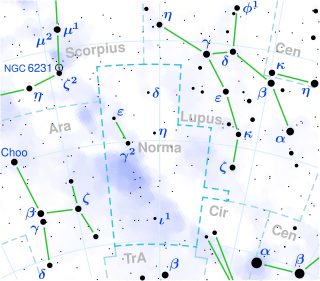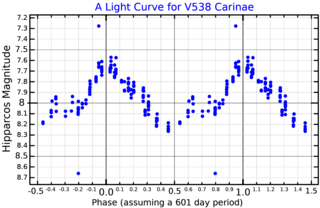Related Research Articles

Chi3 Sagittarii (χ3 Sagittarii) is a solitary, orange-hued star in the zodiac constellation of Sagittarius. It is faintly visible to the naked eye with an apparent visual magnitude of +5.45. Based upon an annual parallax shift of 6.53 mas as seen from Earth, it is located roughly 500 light years from the Sun. It is receding from the Earth with a radial velocity of 39.6 km/s.
Omicron Serpentis is a solitary star in the Serpens Cauda (tail) section of the equatorial constellation Serpens. Based upon an annual parallax shift of 18.83 mas as seen from Earth, it is located around 173 light years from the Sun. The star is visible to the naked eye with a base apparent visual magnitude of +4.26.
Sigma Sculptoris, Latinized from σ Sculptoris, is a solitary, white-hued star in the southern constellation of Sculptor. It is faintly visible to the naked eye with an apparent visual magnitude of +5.54. Based upon an annual parallax shift of 14.04 mas as seen from Earth, it is located about 232 light years from the Sun.

Iota Canis Majoris, Latinized from ι Canis Majoris, is a solitary variable supergiant star in the southern constellation of Canis Major. It is visible to the naked eye with an apparent visual magnitude that varies between +4.36 and +4.40. The distance to this star is approximately 3,100 light years based on parallax measurements. It is drifting further away with a radial velocity of +41.2 km/s.

V382 Carinae, also known as x Carinae, is a yellow hypergiant in the constellation Carina. It is a G-type star with a mean apparent magnitude of +3.93, and a variable star of low amplitude.

HD 96919, also known by its Bayer designation of z2 Carinae and the variable star designation of V371 Carinae, is a blue supergiant star in the constellation Carina. It lies near the Carina Nebula and at a comparable distance.

2 Centauri is a single star in the southern constellation of Centaurus, located approximately 183 light-years from Earth. It has the Bayer designation g Centauri; 2 Centauri is the Flamsteed designation. This object is visible to the naked eye as faint, red-hued star with an apparent visual magnitude of 4.19. It is moving away from the Earth with a heliocentric radial velocity of +41 km/s. The star is a member of the HR 1614 supercluster.
HD 36678 is single star in the northern constellation of Auriga. This star is dimly visible to the naked eye with an apparent visual magnitude of 5.83. It is located at a distance of approximately 840 light years from the Sun based on parallax.

W Andromedae is a variable star in the constellation of Andromeda. It is classified as a Mira variable and S-type star, and varies from an apparent visual magnitude of 14.6 at minimum brightness to a magnitude of 6.7 at maximum brightness, with a period of approximately 397.3 days. The star is losing mass due to stellar winds at a rate of 2.79×10−7M☉/yr.
HD 91496 is a giant star in the constellation Carina, with an apparent magnitude is 4.92 and an MK spectral class of K4/5 III. It has been suspected of varying in brightness, but this has not been confirmed.

28 Monocerotis is a single star in the equatorial constellation of Monoceros. It has an orange-hue and is faintly visible to the naked eye with an apparent visual magnitude of 4.69. The distance to this star is approximately 450 light years based on parallax, and it has an absolute magnitude of −1.00. The star is drifting further away from the Sun with a radial velocity of +26.7 km/s.
Mu Muscae, Latinized from μ Muscae, is a solitary star in the southern constellation of Musca. It is visible to the naked eye as a faint, orange-hued star with an apparent visual magnitude of around 4.75. Based upon an annual parallax shift of 7.21 mas as seen from Earth, it is located about 450 light years from the Sun. The star is drifting further away with a radial velocity of +37 km/s.

Sigma Ophiuchi, Latinized from σ Ophiuchi, is a single, orange-hued star in the equatorial constellation Ophiuchus. Its apparent visual magnitude is 4.31, which is bright enough to be faintly visible to the naked eye. The annual parallax shift of 3.62 mas as seen from Earth provides a distance estimate of roughly 900 light years. It is moving closer to the Sun with a radial velocity of −28 km/s.

31 Pegasi is a single star in the northern constellation of Pegasus. It is visible to the naked eye as a dim, blue-white hued point of light with a baseline apparent visual magnitude of 4.99. It is located approximately 1,600 light years away from the Sun based on parallax, but is drifting closer with a radial velocity of −5.3 km/s.

17 Persei is a single star in the northern constellation of Perseus, located about 390 light years away from the Sun. It is visible to the naked eye as a faint, orange-hued star with an apparent visual magnitude of 4.53. This object is moving further from the Earth at a heliocentric radial velocity of +13 km/s.

HD 51799 is a class M1III star in the constellation Puppis. Its apparent magnitude is 4.95 and it is approximately 860 light years away based on parallax.

21 Persei is a single, variable star in the northern constellation of Perseus, located about 331 light years away from the Sun. It is visible to the naked eye as a faint, white-hued star with an apparent visual magnitude of 5.10 km/s. The object is moving further from the Earth with a heliocentric radial velocity of +8.5 km/s. It has the variable star designation LT Persei; 21 Persei is the Flamsteed designation.
η2 Pictoris, Latinised as Eta2 Pictoris, is a solitary star in the southern constellation of Pictor. It is visible to the naked eye as a dim, orange-hued star with an apparent visual magnitude of 5.02. With an annual parallax shift of 7.8 mas as seen from the Earth, it is located around 418 light years from the Sun. It is a member of the HR 1614 moving group of stars that share a common motion through space.

QU Normae, also known as HR 6131, is a blue supergiant star in the constellation Norma. It is also a variable star, thought to be an α Cyg variable.

V538 Carinae is a variable star in the constellation of Carina, and a possible red supergiant. If this star replaced the Sun in the Solar System, its photosphere would at least engulf the orbit of Mars.
References
- 1 2 3 4 5 van Leeuwen, F. (2007), "Validation of the new Hipparcos reduction", Astronomy and Astrophysics, 474 (2): 653–664, arXiv: 0708.1752 , Bibcode: 2007A&A...474..653V , doi: 10.1051/0004-6361:20078357 .
- 1 2 3 4 5 6 7 Anderson, E.; Francis, Ch. (2012), "XHIP: An extended hipparcos compilation", Astronomy Letters, 38 (5): 331, arXiv: 1108.4971 , Bibcode:2012AstL...38..331A, doi:10.1134/S1063773712050015, S2CID 119257644.
- 1 2 3 4 Zorec, J.; Royer, F. (January 2012), "Rotational velocities of A-type stars. IV. Evolution of rotational velocities", Astronomy & Astrophysics, 537: A120, arXiv: 1201.2052 , Bibcode:2012A&A...537A.120Z, doi:10.1051/0004-6361/201117691, S2CID 55586789.
- 1 2 Houk, Nancy; Cowley, A. P. (1979), Michigan catalogue of two-dimensional spectral types for the HD stars, vol. 1, Ann Arbor, Michigan: Dept. of Astronomy, University of Michigan, Bibcode:1978mcts.book.....H.
- ↑ Samus, N. N.; Durlevich, O. V.; et al. (2009), "VizieR Online Data Catalog: General Catalogue of Variable Stars (Samus+ 2007-2013)", VizieR On-line Data Catalog: B/GCVS. Originally Published in: 2009yCat....102025S, 1: B/gcvs, Bibcode:2009yCat....102025S.
- 1 2 3 4 David, Trevor J.; Hillenbrand, Lynne A. (2015), "The Ages of Early-Type Stars: Strömgren Photometric Methods Calibrated, Validated, Tested, and Applied to Hosts and Prospective Hosts of Directly Imaged Exoplanets", The Astrophysical Journal, 804 (2): 146, arXiv: 1501.03154 , Bibcode:2015ApJ...804..146D, doi:10.1088/0004-637X/804/2/146, S2CID 33401607.
- ↑ "HD 83944". SIMBAD . Centre de données astronomiques de Strasbourg . Retrieved 2020-01-26.
- ↑ Samus, N. N.; et al. (2017), "General Catalogue of Variable Stars", Astronomy Reports, 5.1, 61 (1): 80–88, Bibcode:2017ARep...61...80S, doi:10.1134/S1063772917010085, S2CID 125853869.
- ↑ Gagné, Jonathan; Faherty, Jacqueline K. (August 2018), "BANYAN. XIII. A First Look at Nearby Young Associations with Gaia Data Release 2", The Astrophysical Journal, 862 (2): 12, arXiv: 1805.11715 , Bibcode:2018ApJ...862..138G, doi: 10.3847/1538-4357/aaca2e , S2CID 119196799, 138.
- ↑ Eggleton, P. P.; Tokovinin, A. A. (September 2008), "A catalogue of multiplicity among bright stellar systems", Monthly Notices of the Royal Astronomical Society , 389 (2): 869–879, arXiv: 0806.2878 , Bibcode:2008MNRAS.389..869E, doi:10.1111/j.1365-2966.2008.13596.x, S2CID 14878976.
- ↑ Chini, R.; et al. (2012), "A spectroscopic survey on the multiplicity of high-mass stars", Monthly Notices of the Royal Astronomical Society, 424 (3): 1925, arXiv: 1205.5238 , Bibcode:2012MNRAS.424.1925C, doi:10.1111/j.1365-2966.2012.21317.x, S2CID 119120749.